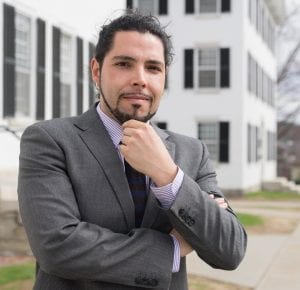NSF Grant Fuels Next Stage of Deadly Waterborne Bacteria Study
 Ongoing research to investigate the behavior of deadly waterborne bacteria recently received a big boost in the form of a National Science Foundation CAREER award.
Ongoing research to investigate the behavior of deadly waterborne bacteria recently received a big boost in the form of a National Science Foundation CAREER award.
The $782,351 award, spread out over five years, further validates the work of Assistant Professor Salvador Almagro-Moreno, Ph.D., and his research into members of the bacterial family Vibrionaceae. Members of this family and many other microbes enter a dormant state under unfavorable conditions such as starvation or in the presence of antibiotics. Almagro-Moreno uses Vibrio cholerae and Vibrio vulnificus, the culprits of cholera and deadly sepsis, respectively, to investigate this poorly understood phenomenon. This is particularly critical as both pathogenic species avoid detection when they go into this dormant state. Almagro-Moreno wants to know the molecular and genetic mechanisms that allow bacteria to do this.
“By understanding how these organisms go from dormant to awake, we can develop ways to detect them and fight them,” said Almagro-Moreno, who contributes biomedical expertise to the interdisciplinary research cluster UCF Coastal.
His past research led to findings in determining how coastal bacteria can become deadly and can be unaffected by antibiotics. This research was also awarded by NSF to further expand the knowledge that Almagro-Moreno was studying with his research team.
From the research on determining how to detect bacteria in a dormant state, Almagro-Moreno says that the bacteria become resistant towards antibiotics and developing a deep understanding of how they regulate this can be used as an “Achilles heel” towards their potential treatment.
“We lose our power the minute we can’t detect something, so it’s critical that we overcome this barrier to studying and treating these pathogens” said Almagro-Moreno.
A separate recent award for Almagro-Moreno’s laboratory is the Scialog fellowship for Mitigating Zoonotic Threats. The award (a combination of the words “science” and “dialogue”) unites early-career scientists from a host of backgrounds to “predict” the next pandemics. According to the Research Corporation for Science Advancement, this includes: “rapid detection, identification, and diagnosis of pathogens and threats; mechanisms and inhibition of emerging and zoonotic disease pathogenesis; new approaches to vaccine development including methods that speed development or lead to broad-spectrum immunity; and modeling of epidemiology leading to actionable approaches to mitigating transmission.”
